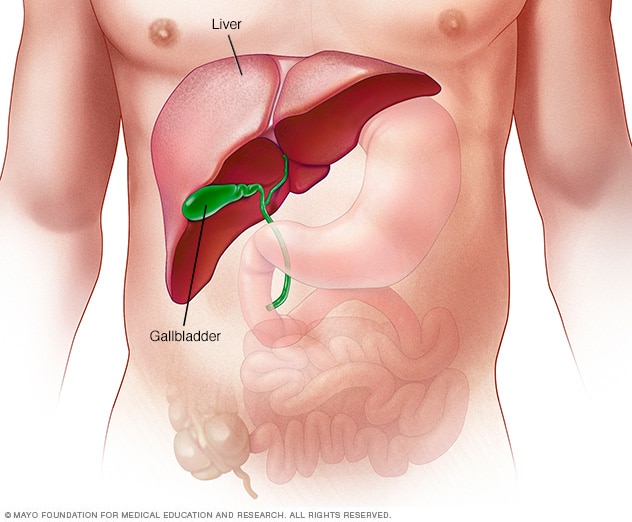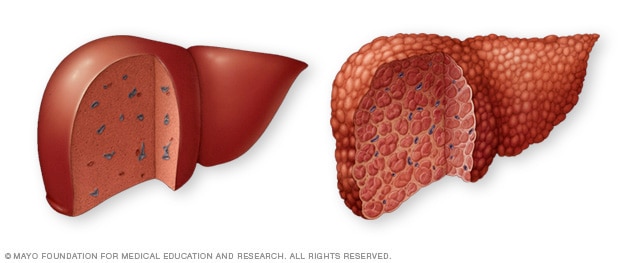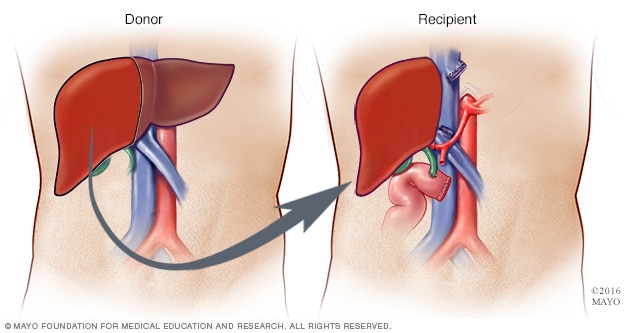Wilson's disease
Updated: 2023-12-02
Overview

The liver
The liver is the largest internal organ in the body. It's about the size of a football. It sits mainly in the upper right portion of the stomach area, above the stomach.
Wilson's disease is a rare inherited condition that causes copper levels to build up in several organs, especially the liver, brain and eyes. Most people with Wilson's disease are diagnosed between the ages of 5 and 35. But younger and older people can be affected too.
Copper plays a key role in building healthy nerves, bones, collagen and the skin pigment melanin. You usually take in copper from the food you eat. Your liver produces a substance called bile that removes any extra copper.
But in people with Wilson's disease, copper isn't removed properly and instead builds up. Sometimes it can be life-threatening if it's not treated. When diagnosed early, Wilson's disease is treatable, and many people with the condition live normal lives.
Symptoms
Wilson's disease is present at birth, but symptoms don't appear until copper levels build up in the brain, liver, eyes or another organ. Symptoms vary based on the parts of your body the disease affects.
These symptoms can include:
- Tiredness and loss of appetite.
- A yellowing of the skin and the whites of the eye, known as jaundice.
- Golden-brown or copper-colored rings around the irises of the eyes, known as Kayser-Fleischer rings.
- Fluid buildup in the legs or stomach area.
- Problems with speech, swallowing or physical coordination.
- Depression, mood changes and personality changes.
- Having a hard time falling asleep and staying asleep.
- Uncontrolled movements or muscle stiffness.
When to see a doctor
Make an appointment with your doctor or other primary care provider if you have symptoms that worry you, especially if a family member has Wilson's disease.
Causes

Autosomal recessive inheritance pattern
Wilson's disease is caused by a changed gene inherited from each parent. Inheriting a changed gene from just one parent rarely affects a person's health. But that person has one changed gene and one typical gene. Two carriers of changed genes have a 25% chance of having a child with two typical genes, a 50% chance of having a child who is a carrier, and a 25% chance of having a child who is affected by Wilson's disease.
Wilson's disease is caused by a changed gene passed down from each parent. If you get only one affected gene, you won't get the disease yourself, but you'll be a carrier. This means you could pass the affected gene to your children.
Risk factors
You can be at greater risk of Wilson's disease if your parents or siblings have the condition. Ask your doctor whether you should have genetic testing to find out if you have Wilson's disease. Diagnosing the condition as early as possible greatly increases the chances of successful treatment.
Complications

Healthy liver vs. liver cirrhosis
A healthy liver, at left, shows no signs of scarring. In cirrhosis, at right, scar tissue replaces healthy liver tissue.
If Wilson's disease isn't treated, sometimes it can lead to death. Serious complications include:
- Scarring of the liver, also known as cirrhosis. As liver cells try to repair damage due to high copper levels, scar tissue forms in the liver. This makes it harder for the liver to work.
- Liver failure. This can occur suddenly — what's known as acute liver failure or decompensated Wilson's disease. It also can come about slowly over years. A liver transplant might be a treatment option.
- Lasting nervous system issues. Tremors, involuntary muscle movements, clumsy walking and having a hard time speaking usually improve with treatment for Wilson's disease. But some people have lasting nervous system problems, even with treatment.
- Kidney problems. Wilson's disease can damage the kidneys, leading to issues such as kidney stones and an unusual number of amino acids removed in the urine.
- Mental health issues. These might include personality changes, depression, irritability, bipolar disorder or psychosis.
- Blood problems. These might include the destruction of red blood cells — what's known as hemolysis. This leads to anemia and jaundice.
Diagnosis

Liver biopsy
A liver biopsy is a procedure to remove a small sample of liver tissue for laboratory testing. A liver biopsy is commonly performed by inserting a thin needle through the skin and into the liver.
Diagnosing Wilson's disease can be hard because its symptoms often are like other liver diseases, such as hepatitis. Also, symptoms can occur over time. Changes in behavior that come on gradually can be especially hard to link to Wilson's disease.
Doctors rely on symptoms and test results to make the diagnosis. Tests and procedures used to diagnose Wilson's disease include:
- Blood and urine tests. Blood tests can monitor your liver function and check the level of a protein called ceruloplasmin that binds copper in the blood. They can check the level of copper in your blood too. Your doctor also might want to measure the amount of copper removed in your urine during a 24-hour period.
- Eye exam. Using a microscope with a high-intensity light, an eye doctor checks your eyes for Kayser-Fleischer rings. This is called a slit-lamp exam. These rings are caused by extra copper in the eyes. Wilson's disease also is related to a type of cataract, called a sunflower cataract. This cataract can be seen during an eye exam.
- Removing a sample of liver tissue for testing, also known as a biopsy. In a biopsy, your doctor inserts a thin needle through your skin and into your liver. Then your doctor draws a small sample of tissue. A laboratory tests the tissue for extra copper.
- Genetic testing. A blood test can pinpoint the genetic changes that cause Wilson's disease. If you have the changed gene that causes Wilson's disease, doctors also can screen any siblings. If any have the changed gene, that sibling can start treatment before symptoms begin.
Treatment

Living liver transplant
During living liver donation, surgeons remove about 40% to 70% of the donor liver and place it into the recipient.
Your doctor might recommend medicines called copper chelating agents. These medicines attach themselves to copper and cause your organs to release that copper into your bloodstream. Your kidneys then filter the copper and release it into your urine.
Treatment then focuses on stopping copper from building up again. For severe liver damage, a liver transplant might be needed.
Medicines
If you take medicines for Wilson's disease, treatment is lifelong. Medicines include:
- Penicillamine (Cuprimine, Depen). Penicillamine is a copper chelating agent. It can cause serious side effects, including skin and kidney issues, and worsen nervous system symptoms. It also can cause bone marrow suppression, so bone marrow can't make enough red blood cells and platelets. Use penicillamine cautiously if you have a penicillin allergy. It also keeps vitamin B6 (pyridoxine) from working. That means you'll need to take a B6 supplement in small doses.
- Trientine (Cuvrior, Syprine). Another copper chelation agent called trientine works much like penicillamine, but it tends to cause fewer side effects. Still, nervous system symptoms can get worse when taking trientine.
- Zinc acetate (Galzin). This medicine stops your body from absorbing copper from the food you eat. It's usually used to stop copper from building up again after treatment with penicillamine or trientine. Zinc acetate might be used as the main therapy if you can't take penicillamine or trientine after completing therapy to remove excess copper or if you have no symptoms. Zinc acetate can upset your stomach.
Your doctor also might recommend ways to treat other symptoms of Wilson's disease.
Surgery
If your liver damage is serious, you might need a liver transplant. During a liver transplant, a surgeon removes your diseased liver and replaces it with a healthy liver from a donor.
Most transplanted livers come from donors who have died. Sometimes a liver can come from a living donor, such as a family member. In that case, the surgeon removes your diseased liver and replaces it with a portion of the donor's liver.
Lifestyle and home remedies
If you have Wilson's disease, your doctor likely will recommend that you limit the amount of copper in your diet. Also, if you have copper pipes in your home, you might want to test the copper levels in your tap water. Be sure to stay away from multivitamins that contain copper.
Foods that contain high amounts of copper include:
- Liver.
- Shellfish.
- Mushrooms.
- Nuts.
- Chocolate.
Ask your healthcare team for more information on foods that have high amounts of copper.
Preparing for an appointment
You'll likely first see your family doctor. Then you might be referred to a doctor who specializes in the liver, also known as a hepatologist.
What you can do
When you make the appointment, ask if there's anything you need to do ahead of time, such as change your diet for blood tests.
Make a list of:
- Your symptoms and when they began.
- Key personal information, including major stresses, other medical conditions you have and any family history of Wilson's disease.
- All medicines, vitamins or other supplements you take, including doses.
- Questions to ask your doctor.
If possible, take a family member or friend along to help you remember the information you're given.
For Wilson's disease, questions to ask your doctor include:
- What tests do I need?
- What treatment do you recommend?
- What are the side effects of the recommended treatment?
- Are there other treatment options?
- I have these other health conditions. How can I best manage them together?
- Do I need to limit the types of food I eat?
- Should I see a specialist?
- Should my family be tested for Wilson's disease?
- Are there brochures or other printed material that I can have? What websites do you recommend?
Don't hesitate to ask other questions.
What to expect from your doctor
Your doctor is likely to ask you several questions, such as:
- Do your symptoms occur all the time or only once in a while?
- How serious are your symptoms?
- How long have you had these symptoms?
- What, if anything, seems to make your symptoms better or worse?
- Does anyone else in your family have Wilson's disease?